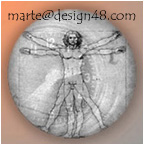
Long before the DaVinci Code
became a ubiquitous part of popular culture, I thought that DaVinci was a great symbol for the webdesigner, because he was both an engineer and an artist. The web has opened up a whole new world for graphic designers, including me. I have been a fulltime webdesigner since 1999, bringing years of computer graphics experience to the web. I handcode HTML (XHTML) and am very familiar with Cascading Style Sheets (CSS). I prefer to hand code, but I can also use any of the WYSIWYG tools, such as Dreamweaver. I find the developers toolbars for both IE and Firefox very handy. I have worked with various content and version management systems, such as Teamsite, Blue Martini, and Accurev. I also design Flash websites. (See the links above and below on this page.) I have done web work for small companies, medium companies, and large companies, for established companies and start-ups. Every company has a website, and it is an ever more important part of their business. Silicon Valley has re-invented itself for the internet. Cisco is now the mothership, as Lockheed was in the 20th century. But, I ask you, what would Cisco be if DARPA net had not been released to the public domain?
Right-brain vs Left-brain
As soon as the internet appeared in the private sector, software companies responded to the need for web tools, and web designers and developers have had to learn to use them. Moreover, because the web is such a visual medium, involving not only technical expertise, but also esthetic sensibilities, software engineers (the "left-brainers") have had to move to the right, towards the visual designers' world, and the "right-brainers" have had to move to the left, and get involved in the functionality part of design. Industrial designers have done this in the past, but only since the web have graphic designers had to be technicians. Now it seems that those most in demand are the people who are both right-brainers and left-brainers. No wonder Leonardo DaVinci is more popular than ever!